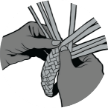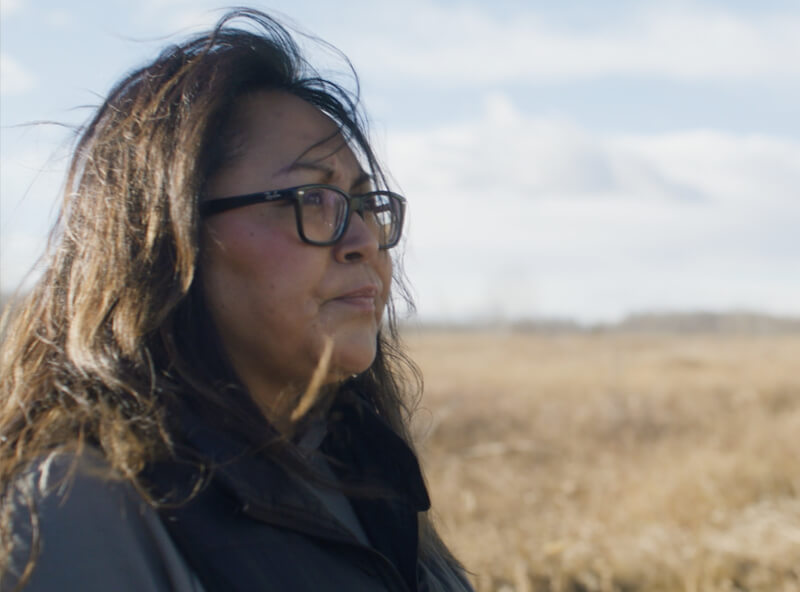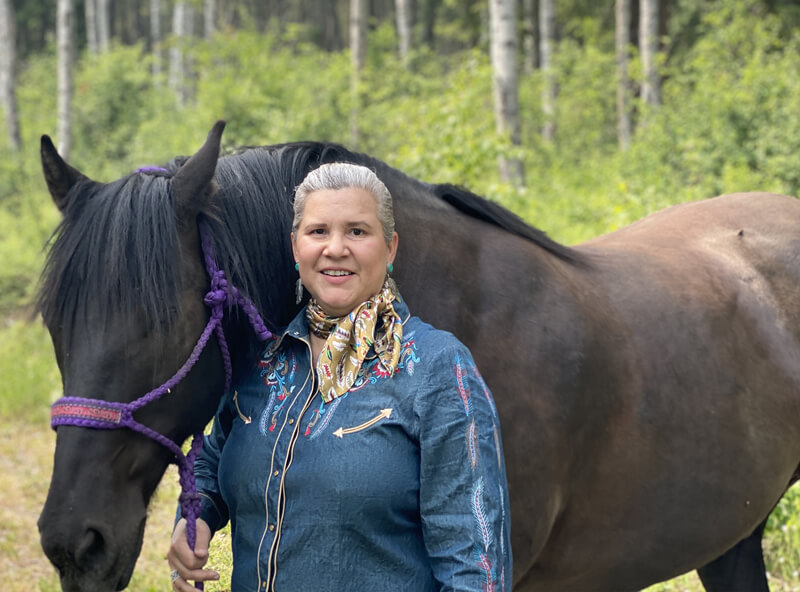
Self-Determination and Inherent Right of Self-Government
Indigenous Peoples exercise and have full enjoyment of their rights to self-determination and self-government, including developing, maintaining and implementing their own institutions, laws, governing bodies, and political, economic and social structures related to Indigenous communities.
Related stories
Actions at a glance
How far along is this work?
Stage of transformation (Salmon)
When we think of life, it’s cycles of transformation. We think of our relations with salmon. Salmon is the chief of the water and a representation of critical thinking, taking action and overcoming obstacles. Their cycle of birth, journey, and returning to the land remind us of our reciprocal responsibility and that, with our limited time on earth, we must contribute in a meaningful way. Salmon return the earth and feed it so that other beings may thrive.
Lowest level

Started
Mid-level

Planning
High Level

Implementation
Transformed

Completed
How complicated is this work?
Complexity (Rock)
How much work needs to be done? How big is the rock we must carry? We call on the image of the rock, which reminds us of the physicality of our test of strength competitions. The heavy lifting is not just about brute strength but about how we position ourselves and use our whole being to lift.
Lowest level

Some complexity
Mid-level

Moderate complexity
High Level

Notable complexity
Transformed

Complexity resolved
Are there challenges?
Risks (Medicine bundle)
The medicine bundle is a symbol of protection and ceremony. When it comes to risk and challenges, we are reminded of the work that our ancestors undertook to prepare mind, body, and spirit for the things creator would place in front of us. Managing risk is achieved through years of preparation, gaining knowledge, training, ceremony, and mastery.
Lowest level

Some challenges
Mid-level

Moderate challenges
High Level

Notable challenges
Transformed

Challenges resolved
How are we working together?
Engagement (Weaving)
Braiding all the necessary pieces together, the land, water, and the people into spaces where deep consultation and co-operation can happen. Each strand is important, each voice is important.
Lowest level

Some engagement
Mid-level

Moderate engagement
High Level

Notable engagement
Transformed

Full engagement
Action
Year
Description
How far along is this work?
How complicated is this work?
Are there challenges?
How are we working together?
-
1.01
2
In partnership with the Government of Canada, establish a new institution designed and driven by First Nations to provide supports to First Nations in their work of nation- and governance-rebuilding and boundary resolution in accordance with First Nations laws, customs and traditions.Ministry of Indigenous Relations and Reconciliation0000 -
1.02
1
Shift from short-term transactional arrangements to the co-development of long-term agreements that recognize and support reconciliation, self-determination, decision-making and economic independence.Ministry of Indigenous Relations and Reconciliation3312 -
1.03
2
Utilize sections 6 and 7 of the Declaration Act to complete and implement government-to-government agreements that recognize Indigenous self-government and self-determination.Ministry of Indigenous Relations and Reconciliation0000 -
1.04
1
Co-develop with Indigenous Peoples a new distinctions-based fiscal relationship and framework that supports the operation of Indigenous governments, whether through modern treaties, self-government agreements or advancing the right to self-government through other mechanisms. This work will include collaboration with the Government of Canada.Ministry of Finance; Ministry of Indigenous Relations and Reconciliation3323 -
1.05
2
Co-develop and implement new distinctions-based policy frameworks for resource revenue-sharing and other fiscal mechanisms with Indigenous Peoples.Ministry of Finance, Ministry of Indigenous Relations and Reconciliation0000 -
1.06
1
Co-develop an approach to deliver on the BC Tripartite Education Agreement commitment, in which the Ministry of Education and the First Nations Education Steering Committee will co-develop legislation that requires local education agreements (LEAs) with First Nations where a First Nation wants one, and that requires the application of the provincial LEA at the request of a First Nation.Ministry of Education and Child Care3113 -
1.07
2
Update the Bilateral Protocol agreement between the BC Ministry of Education and Child Care and the First Nation Education Steering Committee for relevancy, effectiveness, and consistency with the UN Declaration to support First Nation students in the K-12 education system.Ministry of Education and Child Care0000 -
1.08
1
Recognize the integral role of Indigenous-led post-secondary institutes as a key pillar of BC’s post-secondary system through the provision of core funding, capacity funding and the development of legislation. This includes institutes mandated by First Nations, as well as a Métis post-secondary institute being developed by Métis Nation BC.Ministry of Post-Secondary Education and Future Skills3313 -
1.09
2
Work with the Nicola Valley Institute of Technology, and the Urban Native Youth Association to co-develop an urban Indigenous centre that supports the childcare, housing and post-secondary needs of Indigenous learners, and strengthen the capacity of the Native Education College to provide culturally relevant post-secondary opportunities for urban Indigenous learners.Ministry of Post-Secondary Education and Future Skills0000 -
1.10
1
Co-develop modernized emergency management legislation (replacing the Emergency Program Act) with First Nations.Ministry of Emergency Management and Climate Readiness3113 -
1.11
5
Support inclusive regional governance by advancing First Nations participation in regional district boards.Ministry of Municipal Affairs0000
-
Action
1.01
Year
2
Ministry
Ministry of Indigenous Relations and Reconciliation
Description
In partnership with the Government of Canada, establish a new institution designed and driven by First Nations to provide supports to First Nations in their work of nation- and governance-rebuilding and boundary resolution in accordance with First Nations laws, customs and traditions.How far along
is this work?0How complicated
is this work?0Are there
challenges?0How are we
working together?0 -
Action
1.02
Year
1
Ministry
Ministry of Indigenous Relations and Reconciliation
Description
Shift from short-term transactional arrangements to the co-development of long-term agreements that recognize and support reconciliation, self-determination, decision-making and economic independence.How far along
is this work?3How complicated
is this work?3Are there
challenges?1How are we
working together?2 -
Action
1.03
Year
2
Ministry
Ministry of Indigenous Relations and Reconciliation
Description
Utilize sections 6 and 7 of the Declaration Act to complete and implement government-to-government agreements that recognize Indigenous self-government and self-determination.How far along
is this work?0How complicated
is this work?0Are there
challenges?0How are we
working together?0 -
Action
1.04
Year
1
Ministry
Ministry of Finance; Ministry of Indigenous Relations and Reconciliation
Description
Co-develop with Indigenous Peoples a new distinctions-based fiscal relationship and framework that supports the operation of Indigenous governments, whether through modern treaties, self-government agreements or advancing the right to self-government through other mechanisms. This work will include collaboration with the Government of Canada.How far along
is this work?3How complicated
is this work?3Are there
challenges?2How are we
working together?3 -
Action
1.05
Year
2
Ministry
Ministry of Finance, Ministry of Indigenous Relations and Reconciliation
Description
Co-develop and implement new distinctions-based policy frameworks for resource revenue-sharing and other fiscal mechanisms with Indigenous Peoples.How far along
is this work?0How complicated
is this work?0Are there
challenges?0How are we
working together?0 -
Action
1.06
Year
1
Ministry
Ministry of Education and Child Care
Description
Co-develop an approach to deliver on the BC Tripartite Education Agreement commitment, in which the Ministry of Education and the First Nations Education Steering Committee will co-develop legislation that requires local education agreements (LEAs) with First Nations where a First Nation wants one, and that requires the application of the provincial LEA at the request of a First Nation.How far along
is this work?3How complicated
is this work?1Are there
challenges?1How are we
working together?3 -
Action
1.07
Year
2
Ministry
Ministry of Education and Child Care
Description
Update the Bilateral Protocol agreement between the BC Ministry of Education and Child Care and the First Nation Education Steering Committee for relevancy, effectiveness, and consistency with the UN Declaration to support First Nation students in the K-12 education system.How far along
is this work?0How complicated
is this work?0Are there
challenges?0How are we
working together?0 -
Action
1.08
Year
1
Ministry
Ministry of Post-Secondary Education and Future Skills
Description
Recognize the integral role of Indigenous-led post-secondary institutes as a key pillar of BC’s post-secondary system through the provision of core funding, capacity funding and the development of legislation. This includes institutes mandated by First Nations, as well as a Métis post-secondary institute being developed by Métis Nation BC.How far along
is this work?3How complicated
is this work?3Are there
challenges?1How are we
working together?3 -
Action
1.09
Year
2
Ministry
Ministry of Post-Secondary Education and Future Skills
Description
Work with the Nicola Valley Institute of Technology, and the Urban Native Youth Association to co-develop an urban Indigenous centre that supports the childcare, housing and post-secondary needs of Indigenous learners, and strengthen the capacity of the Native Education College to provide culturally relevant post-secondary opportunities for urban Indigenous learners.How far along
is this work?0How complicated
is this work?0Are there
challenges?0How are we
working together?0 -
Action
1.10
Year
1
Ministry
Ministry of Emergency Management and Climate Readiness
Description
Co-develop modernized emergency management legislation (replacing the Emergency Program Act) with First Nations.How far along
is this work?3How complicated
is this work?1Are there
challenges?1How are we
working together?3 -
Action
1.11
Year
5
Ministry
Ministry of Municipal Affairs
Description
Support inclusive regional governance by advancing First Nations participation in regional district boards.How far along
is this work?0How complicated
is this work?0Are there
challenges?0How are we
working together?0
Detailed action item reporting
-
1.02
Shift from short-term transactional arrangements to the co-development of long-term agreements that recognize and support reconciliation, self-determination, decision-making and economic independence.
Highlights
Stz’uminus First Nation and B.C. entered a reconciliation agreement in March 2022 that sets out commitments to work together on community priorities, future land transfers and economic development, while also establishing funding for future environmental remediation activities in Ladysmith Harbour.
The Wei Wai Kum First Nation and the Province signed an Incremental Treaty Agreement in August 2022 that will transfer 2,276 hectares of territorial lands back to Wei Wai Kum and help boost the Nation’s economic activities.
B.C. and the 3Nations Society (Tahltan, Kaska and Taku River Tlingit) renewed and strengthened the regional partnership under an agreement in September 2022. This agreement provides stable funding for ongoing, community-driven initiatives and builds on previous successes.
The Province purchased ranch lands for Stswecem’c Xget’tem First Nation to be returned to as part of treaty negotiations with the Northern Secwépemc te Qelmúcw (NStQ) and entered an umbrella agreement in December 2022 that will help resolve ranching issues in the NStQ treaty negotiations.
Lake Babine Nation and the Province took the next step in the journey to recognize and implement the Nation’s rights and title through the signing of a new land transfer agreement in January 2023.
Several treaty tables are in Stage 5 negotiations with conclusion of some expected in 1-2 years.
Several tables are in reconciliation negotiations outside of the treaty process and are expected to conclude negotiations between 1-3 years.
Long-term agreements demonstrate a structured and intentional approach towards reconciliation. Increasing the number of signed long-term agreements demonstrates emphasis on being intentional about progress toward reconciliation, focused on achieving self-determination, decision-making and economic independence.
Indicators
- The number of agreements signed: Five co-developed long-term agreements that recognize and support reconciliation, self-determination, decision-making and economic independence.
How are we working together?
The negotiation of long-term agreements is a collaborative process with First Nations that requires ongoing engagement. These negotiations involve close working relationships and the co-development of collaborative solutions.
Together, the Province is working with First Nations and the federal government to create innovative agreements that are flexible and better suited to addressing the needs of individual Nations. This past year, the Province signed several unique and diverse agreements to exemplify this action including with the Lake Babine Nation, Wei Wai Kum Nation, Stz’uminus First Nation and others. Engagement is ongoing with First Nations throughout B.C. through regular meetings to negotiate additional agreements to support reconciliation, self-determination, decision-making and economic independence.
Are there challenges?
New and innovative approaches to achieve long-term reconciliation may require new policy and legislation. This work takes time and requires co-ordination within government, as well as co-operation with negotiation partners. As new agreements demonstrate change and positive steps towards reconciliation, there will be increased demand on provincial capacity. Recruiting and retaining knowledgeable and experienced teams is a challenge in the current labour market.
-
1.04
Co-develop with Indigenous Peoples a new distinctions-based fiscal relationship and framework that supports the operation of Indigenous governments, whether through modern treaties, self-government agreements or advancing the right to self-government through other mechanisms. This work will include collaboration with the Government of Canada.
Highlights
In 2022, the Province began an intensive co-development process with First Nations, focused on the vision, principles and objectives of a new fiscal framework and co-development of options for a new forestry revenue sharing model with First Nations. Through this process, the Province received a clear message of change: a new fiscal framework must support a fundamental shift in the way governments work together and support an integrated, rights-based approach to decision-making, stewardship and benefits sharing. This is important work that will support a transition away from the short-term transactional approach of the past towards a new fiscal framework that recognizes, respects and supports Indigenous Peoples’ right to self-determination and self-government.
Indicators
- Strategic engagement underway: New Fiscal Framework Discussion Paper sent to every First Nation in B.C.
- Number of engagement participants in programs and events: 94 First Nations provided feedback on the Discussion Paper (in writing or at meetings).
How are we working together?
- The New Fiscal Framework Discussion Paper released in November 2022, followed by virtual engagement session in January 2023
- First Nations Leaders’ Gathering in November 2022
- Provincial Forestry Forum in November 2022
- Provincewide engagement Fall 2022/Winter 2023
A key focus of the engagement process has been on government-to-government engagement at tables where the Province has made commitments around co-developing a new fiscal framework or new revenue sharing arrangements.
The Ministry of Finance consulted with Modern Treaty Nations on the Budget 2023 measures for treaty property taxation.
Are there challenges?
Given the scale of the work, the commitment to co-develop a new fiscal framework with Indigenous Peoples poses risks from a project management and capacity perspective, for both the Province and First Nations’ governments and organizations. The Province will need to offer a range of consultation and co-operation opportunities during the full five-year span of the Action Plan to ensure it can engage comprehensively with Indigenous Peoples in a way that reflects their diverse interests, needs and priorities.
-
1.06
Co-develop an approach to deliver on the BC Tripartite Education Agreement commitment, in which the Ministry of Education and the First Nations Education Steering Committee will co-develop legislation that requires local education agreements (LEAs) with First Nations where a First Nation wants one, and that requires the application of the provincial LEA at the request of a First Nation.
Highlights
The Ministry of Education and Child Care (ECC) has engaged collaboratively with the First Nations Education Steering Committee (FNESC) to work through problems and come to a consensus on solutions to implement BC Tripartite Education Agreement (BCTEA) commitments. Consultation with Indigenous rights holders on the policy approach is currently ongoing.
Next steps are continuing work on co-development of policy and planning for potential legislative changes.
Indicators
- Strategic engagement underway: Legislation and Policy Working Group formed with FNESC and initial policy development discussions underway.
How are we working together?
ECC and FNESC have had regular meetings since April 2021 to co-develop the Local Education Agreement (LEA) approach. FNESC consulted with First Nation governments prior to the signing of BCTEA in 2018 and over the last four years to ensure First Nation direction was incorporated into a provincial LEA template. In addition to co-development with FNESC, ECC has been engaging with First Nations and Treaty First Nations on the proposed LEA policy since February 2023.
Are there challenges?
Timelines for implementation, legislative changes and ensuring that First Nations and boards of education are appropriately informed of any new policies.
-
1.08
Recognize the integral role of Indigenous-led post-secondary institutes as a key pillar of BC’s post-secondary system through the provision of core funding, capacity funding and the development of legislation. This includes institutes mandated by First Nations, as well as a Métis post-secondary institute being developed by Métis Nation BC.
Highlights
Key components of this action are to ensure that legislation is enacted that recognizes the integral role of First Nations-mandated institutes in the BC post-secondary system and commits to provide ongoing core and capacity funding. This is part of the alignment of laws of British Columbia with Article 14 of the United Nations Declaration on the Rights of Indigenous Peoples. First Nations-mandated institutes play a significant role in First Nation communities, helping to fill gaps where the mainstream education and post-secondary education systems have not been able to adequately support First Nation learners. Their role in supporting First Nation learners to continue their education journey has been and continues to be a key component of BC’s education system and for this reason, the institutes need to be recognized through legislation.
Planning funding has been secured to support Métis Nation BC (MNBC) with institute development and discussions are ongoing regarding possible governing structures through ongoing meetings.
Indicators
- Amount of funding provided: One-time core funding of $4 million for First Nations mandated institutes provided in 2022/23 with an ongoing commitment of $6.7 million in annual core and capacity funding for First Nations-mandated institutes in the Stronger BC: Future Ready Action Plan.
How are we working together?
Consultation and collaborative development with the First Nations Education Steering Committee (FNESC) and the Indigenous Adult and Higher Learning Association (IAHLA) regarding the funding of First Nations-mandated post-secondary institutes predates the Declaration Act Action Plan and continues through regular meetings and collaborative policy development for the legislation and future requests for increased funding. Consultation on the legislation will be conducted with First Nations and engagement with the First Nations Leadership Council is planned.
The Ministry is taking a distinctions-based approach to implementing this action. As such, we are having separate discussions with FNESC and IAHLA and with the Métis Nation BC (MNBC).
Are there challenges?
Ongoing core and capacity funding for First Nations-mandated institutes has been secured as part of the StrongerBC: Future Ready Action Plan. Collaboratively developing all aspects of this policy and legislative initiative is complex and is taking some time to work through.
-
1.10
Co-develop modernized emergency management legislation (replacing the Emergency Program Act) with First Nations.
Highlights
The Ministry of Emergency Management and Climate Readiness (EMCR) has engaged in legislation and regulation co-development with First Nations title and rights holders, the First Nations Leadership Council, the Alliance of BC Modern Treaty Nations and a range of other service organizations. Modernized legislation is expected to be introduced in Fall 2023. Co-development and engagement opportunities will continue to shift to focus on regulations to be made under the new Act over the coming months and beyond. Some draft implementation plans and tools are also in development.
Significant policy shifts that align with the Declaration Act include the following: recognizing First Nations rights and the role of Indigenous governing bodies in relation to emergencies; enabling agreements with Indigenous governing bodies to support collaboration and decision-making; requiring consultation and co-operation with Indigenous governing bodies across the phases of emergency management and prior to taking land-based response actions; embedding cultural safety in all phases of emergency management; and including Indigenous knowledges in risk assessments and plans.
Indicators
- Legislation drafted: Draft Emergency Disaster Management Act is complete and is planned to be introduced in Fall 2023.
How are we working together?
Engagement initiated in 2019 laid the groundwork for the new legislation. The COVID-19 pandemic suspended the process, then in 2022, EMCR reset the engagement process and began the co-development process with First Nations. Throughout 2022, EMCR hosted regional sessions with First Nations to inform updated policy intentions and legislative development. Legislation was shared with First Nations in late Fall 2022 and revised based on feedback. Engagement with First Nations will inform development of regulations.
Are there challenges?
The project involves time constraints and engagement timelines are compressed. Timelines have been reset at several points.
Capacity for all 203 First Nations to participate in the co-development process is limited by resources. Some communities are still in recovery from emergency events in their communities. The team is considering ways to minimize engagement fatigue and to enable more partners to participate.
A standardized process, which involved participation across the provincial government and engagement with Indigenous partners, guided the development of the Declaration Act Annual Report. This process involved lead ministries identifying when each of the 89 actions in the Declaration Act Action Plan was forecasted to begin substantial implementation (by year), in consideration of logical sequencing of actions that build upon each other, balancing with other commitments, and overall balancing of action plan themes, ministries, sectors, and focus areas.
Once year 1 actions were confirmed, the process involved creating and validating a reporting process for those actions in active implementation; lead Ministries developing and submitting reporting information, often in partnership with Indigenous organizations they work with; and an overall review to ensure accuracy, quality and completeness,.
The reporting information was then used to prepare both the implementation status dashboard and the detailed reporting presented. The calculation of the four icons in the dashboard followed the following method:
How far along is this work?
Determined using standard project schedule stages:
- Planning
- Implementing
- Complete
How complicated is this work?
Calculation: number of identified subtasks for each action + number of Ministries involved in each action + number of years in the planning and implementing stages for each action.
Categorization:
- Some Complexity: score of 4 or less
- Moderate Complexity: score of 5-6
- Notable Complexity: score of 7+
Are there challenges?
Calculation based on “risks” and “obstacles” identified for each action.
How are we working together?
Calculation: yes/no responses to the following questions for each action:
- Partner(s) identified?
- Consultation and co-operation plan or approach is in place or in development with Indigenous partners?
- Partner(s) involved in report development/co-development?
- Input has been gathered/meetings have been held?
Categorization:
- No engagement: score of 0
- Some engagement: score of 1-2
- Moderate engagement: score of 3
- Notable engagement: score of 4
The resulting reporting information was adapted based on input from internal provincial committee processes and from Indigenous partners, including the First Nations Leadership Council, the Alliance of BC Modern Treaty Nations, and Métis Nation British Columbia.
The stories profiled throughout this website were curated based on a consistent set of criteria: they tell a story that involves human impact; there is balance across action plan themes, sectors, geographic region, and lead Ministries; consideration is paid to a distinctions basis; there is substantive progress in advancing the action; and there is an ability to develop content within the project timelines.
There are limitations resulting from the methods used to develop the reporting content, and inherent to undertaking a project of this nature for the first time. These limitations include:
- As this is the first year of the action plan and associated annual report, indicators are mainly process and activity-focused, and as yet not reflective of longer, more meaningful, or more transformational outcomes.
- Standardization of report content, including indicators, was balanced with the work of co-development.
- The project benefitted from learning while doing, meaning that the standardized template and associated dashboard calculations and representation were adapted throughout the process.


